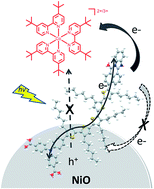A study of oligothiophene–acceptor dyes in p-type dye-sensitized solar cells†
Abstract
Two new dyes, E1 and E2, equipped with triphenylamine as the electron donor, oligothiophene as the linker and different electron acceptor groups, have been designed and synthesized as photosensitizers for p-type dye-sensitized solar cells (p-DSCs). A systematic study of the effect of molecular structures on the observed photophysical properties, the electron/hole recombination process, the overall performance and the interfacial charge separation was carried out. Transient absorption spectroscopy (TAS) shows that the E1 dye with a napthoilene-1,2-benzimidazole (NBI) unit as the acceptor has a longer lifetime in the reduced state than the E2 dye with a malononitrile subunit on the NiO surface.


 Please wait while we load your content...
Please wait while we load your content...